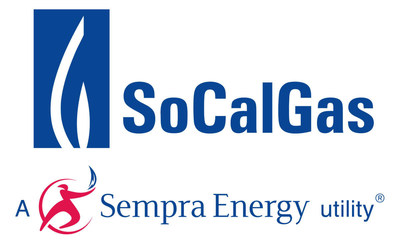RIVERSIDE, Calif., Aug. 30, 2018 /PRNewswire/ -- The University of California, Riverside College of Engineering Center for Environmental Research and Technology (CE-CERT) and Southern California Gas Co. (SoCalGas) today announced the results of a new study on ultra-low emission natural gas heavy-duty engines, showing a new 11.9-liter engine achieved California's lowest smog-forming emissions standard, and maintained those emission during all types of driving. The study results underscore the ability of the near-zero truck engines to clean the air: most heavy-duty vehicles on roads today are predominantly diesel-powered and represent one of the largest sources of nitrogen oxide (NOx), or smog-forming, emissions and fuel consumption in North America. By contrast, the new near-zero emissions 12-liter engine, made by Cummins Westport, is the only heavy-duty engine in the category to not only meet, but exceed, the California Air Resources Board's cleanest optional low-NOx standard of 0.02 g/bhp-hr.
Kent Johnson, assistant research engineer at CE-CERT, led the tests on the near-zero emissions natural gas engine. The evaluation included regulated and non-regulated emissions, ultrafine particles, global warming potential, and fuel economy. The testing was performed during in-use testing on a dynamometer that simulated various types of driving conditions, from pulling into a loading dock to regional hauling. Johnson performed similar testing on an 8.9-liter near-zero natural gas engine last year. Those results found the smaller engine had even lower emissions than California standards will require in the near future—in some driving conditions, almost zero.
"The first study was a smaller engine intended for use in school buses and trash trucks, which are only about 30 percent of the heavy-duty inventory. The new engine is for drayage and movement of goods, or 70 percent of the inventory. This engine technology is good not only for the smaller work-force applications of transit and refuse, but also for hauling loads around Southern California," Johnson said.
"The transportation sector accounts for more than 80 percent of smog-forming emissions in California," said Sharon Tomkins, vice president of customer solutions and strategy for SoCalGas. "The test results from UC Riverside once again shows the latest natural gas engine technology, which is available and on the road today, will play a vital role in achieving California's clean air goals."
"The Energy Commission is pleased to support, along with South Coast Air Quality Management District and SoCalGas, the initial testing of this cleaner low NOx Cummins engine and glad to see it has been certified by the California Air Resources Board," said California Energy Commission Commissioner Janea A. Scott. "This type of near-zero pollution engine adds to the growing number of clean energy technologies being developed to reduce pollution in efforts to meet California's clean air standards and is particularly important in Southern California where air quality continues to be a challenge and freight movement represents a third of the region's economy."
"Large scale and accelerated deployment of near zero-emissions engine technology is vital for achieving the necessary emission reductions to achieve federal air quality standards in 2023 and 2031," said Wayne Nastri, executive officer of the South Coast Air Quality Management District. "To meet our air quality goals, we must continue to see improvements in the transportation sector, which contributes the most air pollution in our region."
About 41 percent of the state's greenhouse gas (GHG) emissions come from transportation. When near-zero emission natural gas trucks are fueled by renewable natural gas, GHG emissions can be reduced by at least 80 percent. Already, close to 70 percent of natural gas fleets in California are fueled with renewable natural gas and is expected to continue to climb this year.
The full study, funded by the South Coast Air Quality Management District, the California Energy Commission and SoCalGas, can be found here.
About the University of California Riverside's CE-CERT:
Distinguished by more than 50 years of high-impact research, the University of California at Riverside has become one of the leading institutions for the exploration of society's most pressing environmental challenges in air, energy, and transportation. CE-CERT's research focus is on using technology to achieve environmental sustainability, an ambitious goal that will require innovation in many different areas. From working to understand how emissions impact air quality to developing technologies needed to improve solar and other renewable power sources, the projects that our research teams are currently engaged in support one of more of the following focus areas: clean air, sustainable transportation, renewable fuels, climate change, and renewable energy and smart grids. Learn more at: http://www.cert.ucr.edu.
About SoCalGas
Headquartered in Los Angeles, SoCalGas® is the largest natural gas distribution utility in the United States. SoCalGas delivers affordable, reliable, clean and increasingly renewable natural gas service to 21.8 million customers across 24,000 square miles of Central and Southern California, where more than 90 percent of residents use natural gas for heating, hot water, cooking, drying clothes or other uses. Natural gas delivered through the company's pipelines also plays a key role in providing electricity to Californians—about 60 percent of electric power generated in the state comes from gas-fired power plants.
SoCalGas is committed to investing in its natural gas system infrastructure, while keeping bills affordable for our customers. From 2013 through 2017, the company spent nearly $6 billion to upgrade and modernize its natural gas system to enhance safety and reliability. The company is also committed to being a leader in the region's clean energy future, and is working to accelerate the use of renewable natural gas from dairy farms, landfills and wastewater treatment plants and the development of renewable energy storage technologies. SoCalGas is a subsidiary of Sempra Energy (NYSE: SRE), an energy services holding company based in San Diego. For more information visit socalgas.com/newsroom or connect with SoCalGas on Twitter (@SoCalGas), Instagram (@SoCalGas) and Facebook.

SOURCE Southern California Gas Company